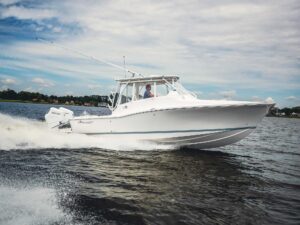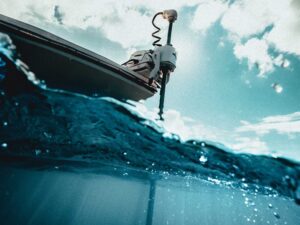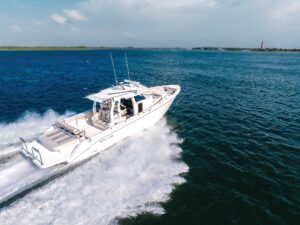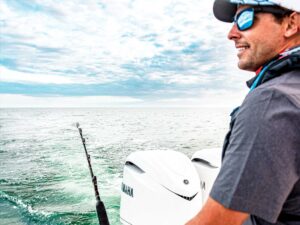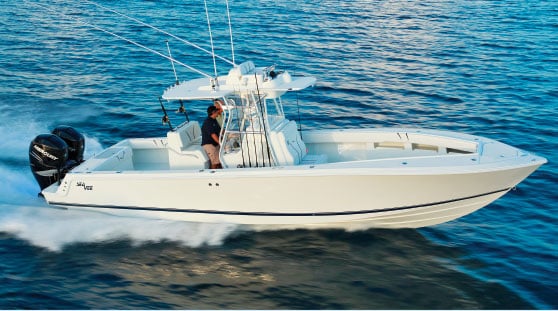
boat towers
These days, you ain’t cool unless your boat’s got a hardtop. Indeed, among the new boats featured editorially in Sport Fishing during the past 12 months, more than 70 percent boasted hardtops, while around 13 percent sported canvas tops with permanent frames (as opposed to Bimini tops with fold-down frames). The remaining boats? Well, many were flats skiffs and bay boats without tops.
Boatbuilders and marine fabricators continually streamline hardtop designs and integrate new features, making these structures much more than places to retreat from the sun. But does that mean you should automatically opt for a hardtop on your fishing boat, be it new or an older craft? Not by a long shot. Canvas-top structures offer advantages of their own.
Cost Comparison
Whether you’re outfitting a center-console, dual‑console, walkaround cuddy, express or convertible, you’ll find a hardtop costs more than a comparable canvas-top structure. Most hardtops are fiberglass, with inner cores and gelcoat finishes on both sides. They often include complexities such as built-in electronics boxes, stereo speakers, LED dome lights and spreader lights. Some even have sunroofs and molded-in running lights.
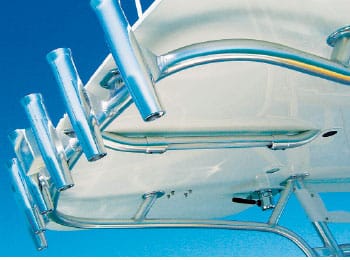
| |Robust hardtops allow boatbuilders such as SeaVee to integrate features like second stations (top) and overhead LED lights (above). (COURTESY SEAVEE BOATS)|
Creating a top from canvas, on the other hand, is usually less expensive, even when undertaken by an expert canvas shop using top-quality Stamoid or Sunbrella marine fabrics. Still, most boat buyers gravitate to hardtops.
“Ninety-nine percent of our customers order hardtops,” says Ariel Pared of SeaVee Boats, which offers both styles. “Customers like that you can almost seamlessly integrate features such as dome lights and stereo speakers into a hardtop,” Pared reveals.
“Many customers like the Key West-style tops with the narrower width in front to allow for vertical rod storage along the center-console.” For its 320 series — four models with LOAs measuring 32 feet, 5 inches — SeaVee lists a custom canvas T-top option for $7,100. The custom hardtop option lists for $10,800 — 52 percent more than fabric.
Hardtops cost more in the aftermarket as well, whether you are commissioning a customized top or considering a prefabricated universal top from a company such as Atlantic Towers or Fishmaster. To give you an idea, Atlantic sells its canvas WalkAround “Tee” Top — a prefab top for most cabin boats up to 25 feet — for $1,999, while the hardtop version retails for $2,499.
Weight Factor
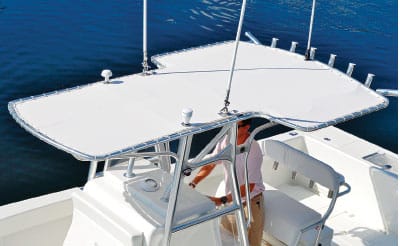
| |Canvas tops such as this Key West-style T-top are significantly lighter than hardtops, and that helps improve fuel economy and reduce roll in big seas on boats less than 25 feet in length. (COURTESY SEAVEE BOATS)|
Both types of tops usually have lightweight welded and anodized or powder-coated aluminum frames. Yet a canvas top saves weight versus a comparably sized top that’s constructed from fiberglass or other material such as a high-density polymer. A square yard of marine canvas weighs about a pound or two, while a square yard of fiberglass laminate tips the scales at 11 pounds or more.
This weight savings becomes a critical advantage on boats less than 25 feet in length or models with relatively narrow beams. Canvas tops help keep these boats from becoming top-heavy and rolling excessively. The same applies to convertibles and express models with towers. A canvas top over the second-station minimizes the mass aloft.
Reducing weight also helps improve fuel efficiency to extend fishing range, as well as on-road mileage while trailering a boat.
Longevity
Hardtops last longer than canvas tops. Even the best canvas eventually succumbs to UV, which leads to rotting and tearing, especially along the stitches and grommets. Canvas might endure for a decade or more, but a hardtop usually will last the lifetime of the boat. However, the canvas top itself is relatively inexpensive; you can usually replace the fabric two or three times for the extra cost of a hardtop.
In either case, maintenance helps ensure maximum longevity. Clean the canvas tops and spray them periodically with a water-repellent formula such as 303 Fabric Guard. Keep a coat of wax on fiberglass tops. And meticulously wash aluminum frames to get rid of salt residue and to prevent corrosion.
Expandability
A hardtop lends itself to adding accessories because you can bolt through the top. This means, for example, you easily can add rod holders, outriggers, antennas, a radar dome, spotlight, FLIR camera, spreader lights and overhead electronics boxes. Just be sure to include beefy backing plates when mounting such items. Hardtops also make it simpler to add an enclosure, since you can fasten canvas tracks and snaps to the top.
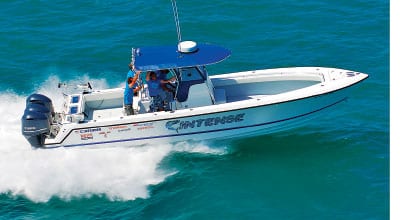
| |Plates welded into the frame under the canvas accommodate elements such as antenna mounts and the radar dome on this T-top. (COURTESY CONTENDER BOATS)|
In addition, hardtops can support a decent amount of weight, making them good places to install relatively heavy items such as an emergency life-raft pack. Some hardtops can even support a person or two, as well as the framework and helm for a tower-style second station. On these tops, you will find the topside finished with nonskid for better footing.
That’s not to say that canvas tops can’t accommodate accessories; you just have to plan for them in advance — during the frame’s design and fabrication process. For mounting antennas and a radar dome, for instance, the frame should have plates welded at strategic positions. The same goes for an overhead electronics box, spreader lights and tracks for attaching enclosure panels. For securing rod holders, an extra bar is often welded on the aft edge of the top’s frame.
While hardtops are the rage, a canvas-top structure might well have a place on your fishing boat, particularly if you need to shave some weight or save a few dollars.
Arch Rival
Few boats come new with arches today because most buyers opt for hardtops. Yet arches do have a place in the fish-boat market, according to Steve Tull, owner of Atlantic Towers, which offers a variety prefabricated tops, towers and arches.
“We sell most of our arches to owners of older walkarounds with existing, serviceable Bimini enclosures,” Tull says. “These boaters are often looking for a place to mount their first radar, and an arch that installs over the Bimini is a more cost-effective option than getting a new hardtop, which also requires a new enclosure.”
Even though an arch does not provide shade, it also gives you a place to mount rod holders, antennas and outriggers, as well as serving as a sturdy grab handle in rough seas, Tull says.
Tower and Top Contacts
303 Fabric Guard
Chicago, Illinois
800-367-3245
303products.com
Atlantic Towers
Bayville, New Jersey
800-831-8889
atlantictowers.com
Fishmaster
Cumming, Georgia
877-777-8693
fishmaster.com
Stamoid
Fort Lauderdale, Florida
954-942-3600
yachting.sergeferrari.com
Sunbrella
Glen Raven, North Carolina
336-221-2211
sunbrella.com

